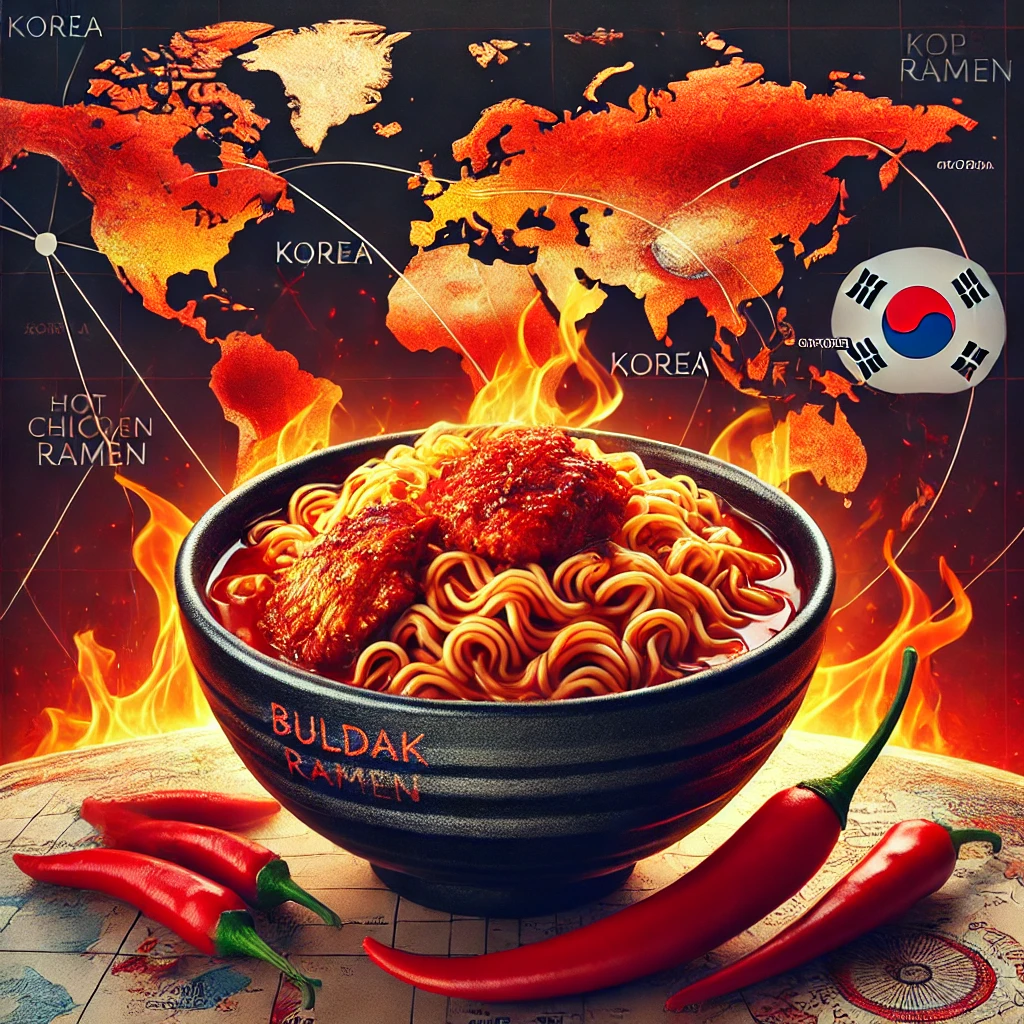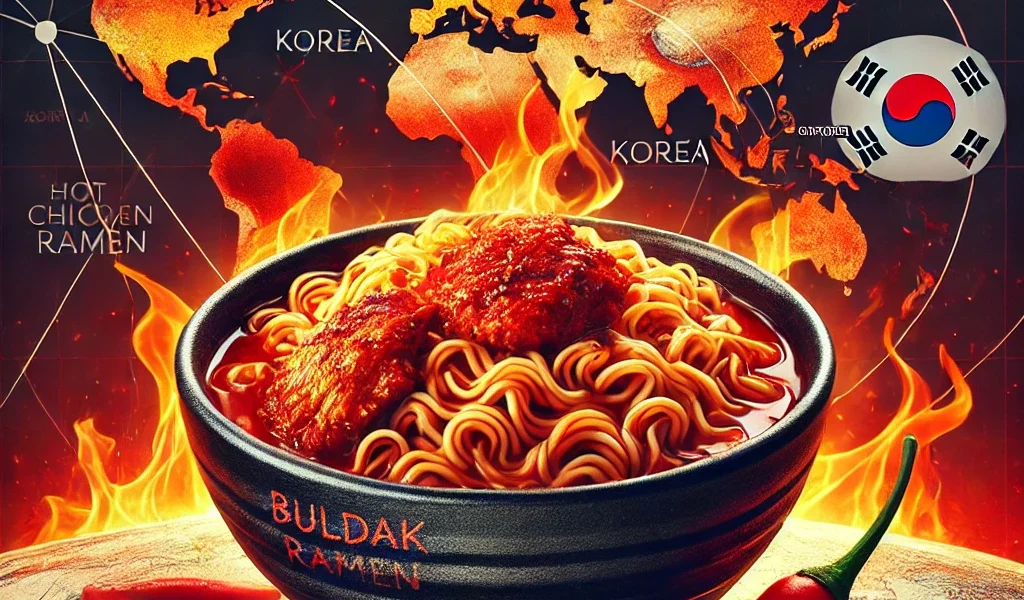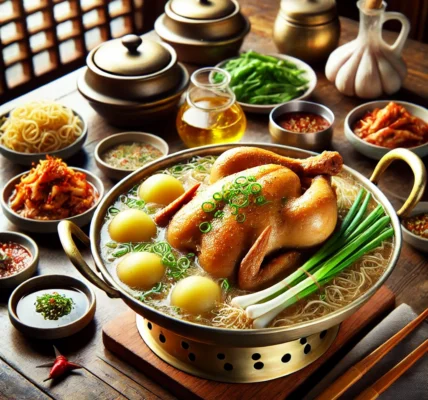How Buldak Ramen Became Korea’s Leading Export Product
Introduction: The Rise of Buldak Ramen
Buldak Ramen, also known as Hot Chicken Flavor Ramen, has become synonymous with Korean spicy food culture. While South Korea is known for its rich culinary traditions, Buldak Ramen’s fiery flavor has captivated global markets, making it one of the country’s top food exports. But how did a product originally considered too spicy for mass consumption become an international sensation?

The Early Days: Humble Beginnings
Samyang Foods, a company historically known for producing Korea’s first instant noodles, launched Buldak Ramen in 2012. Initially, it wasn’t an overnight success. In fact, its extreme spice level alienated many consumers, leading to lackluster sales during its early release. Consumers at the time found the noodle dish too overwhelming, with many complaints about the discomfort caused by its intense heat.
Despite these setbacks, a dedicated group of spice-loving fans began sharing their love for the product on social media platforms, such as YouTube and Instagram. The combination of viral challenges, particularly the “Fire Noodle Challenge,” quickly spread across the globe, introducing people everywhere to the unique experience of trying to conquer the spicy noodles.
Buldak Ramen’s Marketing Strategy: Let the Fans Do the Talking
What set Buldak Ramen apart from other food products was its unique marketing approach—or lack thereof. Samyang Foods didn’t invest in massive marketing campaigns. Instead, the noodles’ growing popularity stemmed organically from online trends and word of mouth. As fans shared videos of themselves eating the noodles, often in extreme situations, the brand became synonymous with challenge culture.
This “spicy challenge” caught the attention of global audiences, with food enthusiasts and influencers eagerly participating in the viral phenomenon. Videos of people attempting to eat the noodles garnered millions of views, helping boost international sales without the need for traditional advertising.
Why Did It Work? A Perfect Timing and Trend Alignment
The success of Buldak Ramen can largely be attributed to timing and a shift in global food trends. By the time the product gained traction in 2013, consumers worldwide were becoming more adventurous in their food choices. Korean cuisine, in particular, was enjoying a moment in the spotlight, thanks to the popularity of K-pop, Korean dramas, and the increasing global reach of Korean culture (Hallyu).
In the US, the influence of Mexican cuisine, known for its spicy dishes, played a significant role in making Buldak Ramen appealing to spice-loving Americans. In Southeast Asia, a region already familiar with spicy food, the noodles found a natural fanbase.
Furthermore, the “food challenge” culture emerging on YouTube contributed significantly. Viewers were fascinated by seeing individuals endure Buldak Ramen’s infamous spice level, propelling it to viral status and boosting demand.
The Global Expansion: Export Success
Thanks to its growing global popularity, Buldak Ramen became one of Korea’s top export products. By 2015, its overseas sales surpassed domestic sales, with China, Southeast Asia, and even the United States becoming major markets.
What made the product particularly appealing in international markets was its adaptability. While Samyang initially only produced the original, extremely spicy version, they later diversified the lineup to cater to different palates. Variants like Cheese Buldak Ramen and Carbonara Buldak Ramen were introduced to offer milder alternatives, ensuring that a wider range of consumers could enjoy the product.
According to Samyang Foods, Buldak Ramen accounted for over 80% of their international sales by 2020, with the brand growing steadily year after year.
Challenges and Future Outlook
Despite its phenomenal success, Buldak Ramen’s journey hasn’t been without challenges. The global spicy food trend that helped propel its popularity may not last indefinitely, and consumer preferences are always evolving. While Buldak Ramen has successfully established itself as a leading global product, it faces the challenge of remaining relevant as tastes shift.
Additionally, while the product has found a solid foothold in Asia and certain Western countries, it remains less popular in Europe, where spiciness is less integral to traditional cuisine. Expanding into these markets may require more tailored marketing approaches and product adaptations.
Samyang Foods continues to innovate, releasing new flavors and products to maintain its competitive edge in the global market. Whether the spicy noodle trend will continue or shift remains to be seen, but for now, Buldak Ramen stands tall as a symbol of Korea’s global culinary influence.
Conclusion: A Global Spicy Icon
Buldak Ramen’s rise from a niche, spicy novelty to a global food sensation demonstrates the power of viral marketing, consumer challenges, and changing food trends. Today, Buldak Ramen is not just a beloved snack but a cultural phenomenon that has helped establish Korean food as a global force. For Samyang Foods, it’s a reminder that sometimes, it takes a bit of heat to find success.














4 COMMENTS